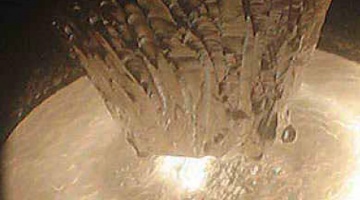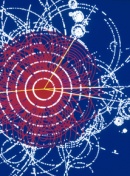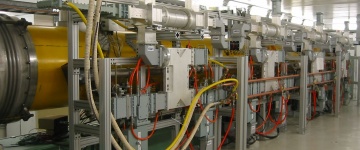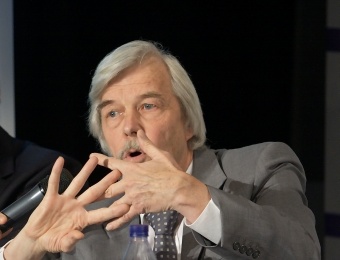Image of the week
International Europhysics Conference on High-Energy Physics
During the 2011 Europhysics Conference on High-Energy Physics (HEP 2011) press conference, CERN Director General Rolf Heuer ad libbed for the journalists an explanation of the role of the Higgs boson in the standard model of subatomic particles...with his two hands. "We know everything about the Higgs boson except whether it exists," he concluded. View more photos
View videos from the conference. |
In the News
-
from Der Spiegel27 JulyDenn gleich zwei Experimente der Physiker liefern Hinweise auf die Existenz des Higgs Bosons: Die LHC-Detektoren “Atlas” und “CMS” registrierten eine ungewöhnliche Häufigkeit von leichteren Teilen im Massebereich von 130 bis 145 Giga-Elektronenvolt (GeV).
-
from Fermilab Today27 July 2011Scientists of the CDF and DZero collaborations at Fermilab continue to increase the sensitivity of their Tevatron experiments to the Higgs particle and narrow the range in which the particle seems to be hiding.
-
from Le Figaro26 July 2011«Je sais que c’est difficile, mais il faut être patient», assure Rolf Heuer, le directeur général du Cern. Il refuse, comme ses collègues, de sauter le pas et de confirmer la découverte du boson de Higgs, mais son petit sourire en coin trahit tout de même son excitation.
-
from Deutschlandradio26 July 2011Der Nachfolger des 27 Kilometer großen Beschleunigerrings könnte den Namen “CLIC” tragen. Das Konzept dazu wurde auf der Europäischen Teilchenphysik-Konferenz in Grenoble vorgestellt.
-
from Fermilab Today25 July 2011A new result from Fermilab’s DZero experiment was announced Saturday at the European Physical Society conference in Grenoble, France, studying the production of the top quark and its antimatter counterpart, the antitop quark, in proton-antiproton collisions.
-
from Nature News25 July 2011When its experiments started in earnest earlier this year, many scientists hoped that the world’s most powerful collider would turn up new particles, additional dimensions and perhaps even a small black hole or two. But beyond a handful of unusual events, the latest data from the Large Hadron Collider (LHC) are frustratingly ordinary.
-
from New Scientist25 July 2011The Higgs boson is still missing – but perhaps we should be more worried about what else the Large Hadron Collider hasn’t found yet.
-
from Nature News23 July 2011Newly released observations of the top quark — the heaviest of all known fundamental particles — could topple the standard model of particle physics. Data from collisions at the Tevatron particle accelerator at Fermilab in Batavia, Illinois, hint that some of the top quark’s interactions are governed by an as-yet unknown force, communicated by a hypothetical particle called the top gluon.
-
from symmetry breaking22 July 2011…Finding the tell-tale sign of a Higgs boson among all other particle signatures is like searching for a drop of ink in an ocean. Only if the accelerators produce more and more collisions do scientists stand a chance of finding enough evidence for the Higgs particle.
-
from Nature News22 July 2011For now, physicists are only willing to call them ‘excess events’, but fresh data from two experiments at the Large Hadron Collider (LHC) are hinting at something unusual — and it could be the most sought-after particle in all of physics.
-
from Science Now22 July 2011Physicists working with the world’s largest atom smasher may have spotted evidence of the long-sought Higgs boson. At least that’s the unofficial result that has the 800 physicists here for the biannual Europhysics Conference on High-Energy Physics abuzz.
-
from The Guardian22 July 2011Scientists may have caught their first glimpse of the elusive Higgs boson, which is thought to give mass to the basic building blocks of nature.
-
from physicsworld.com22 July 2011The latest data from experiments at the Large Hadron Collider (LHC) leave significantly less room for the Higgs boson to hide – that is the take-home message from the Europhysics Conference of High-Energy Physics in Grenoble, France.
-
from Fermilab20 July 2011Scientists of the CDF collaboration at the Department of Energy’s Fermi National Accelerator Laboratory announced the observation of a new particle, the neutral Xi-sub-b.
Copyright © 2025 ILC International Development Team




